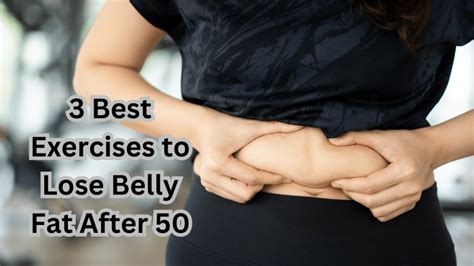
Shedding stubborn belly fat after 50 doesn’t require endless crunches or meticulous calorie counting, according to experts who advocate for a holistic approach encompassing strength training, balanced nutrition, stress management, and adequate sleep. Focusing on these lifestyle adjustments can be more effective in reducing abdominal fat and improving overall health for individuals in their 50s and beyond.
As individuals age, hormonal shifts and metabolic changes often make losing belly fat more challenging, with visceral fat—the fat stored deep within the abdomen—posing significant health risks, including increased risk of heart disease, type 2 diabetes, and certain cancers. Traditional methods like crunches target abdominal muscles but do little to reduce visceral fat. Instead, a comprehensive strategy is needed.
“As women approach menopause, estrogen levels drop, which leads to an increase in abdominal fat,” says Dr. Melissa Macher, an OB/GYN at Cleveland Clinic. This hormonal change, combined with a natural decline in muscle mass, contributes to a slower metabolism and a greater tendency to store fat around the midsection.
Strength training is crucial for building muscle mass, which helps boost metabolism and burn more calories, even at rest. Compound exercises like squats, deadlifts, and lunges engage multiple muscle groups simultaneously, maximizing calorie burn and promoting fat loss.
Nutrition plays a vital role in reducing belly fat. A balanced diet rich in lean protein, whole grains, fruits, and vegetables provides the necessary nutrients to support muscle growth and overall health. Limiting processed foods, sugary drinks, and excessive saturated and unhealthy fats can also help reduce calorie intake and promote fat loss. “Focus on a diet rich in whole, unprocessed foods,” advises registered dietitian, Sarah Koszyk. “Prioritize protein, fiber, and healthy fats to keep you feeling full and satisfied.”
Stress management is another essential component of a successful belly fat reduction strategy. Chronic stress can lead to increased cortisol levels, which can promote fat storage in the abdominal area. Techniques such as meditation, yoga, and deep breathing exercises can help reduce stress and improve overall well-being. Engaging in hobbies and spending time with loved ones can also help lower stress levels.
Adequate sleep is often overlooked but plays a critical role in weight management. Lack of sleep can disrupt hormones that regulate appetite, leading to increased cravings and overeating. Aiming for 7-9 hours of quality sleep each night can help regulate hormones, reduce stress, and support overall health. Establishing a consistent sleep schedule and creating a relaxing bedtime routine can improve sleep quality.
In addition to these lifestyle adjustments, consulting with a healthcare professional or a registered dietitian can provide personalized guidance and support. They can assess individual needs and develop a tailored plan that addresses specific health concerns and goals.
The misconception that crunches are the key to losing belly fat is deeply ingrained, but experts emphasize that spot reduction is not possible. Crunches can strengthen abdominal muscles, but they do not directly target visceral fat. Instead, a holistic approach that combines strength training, balanced nutrition, stress management, and adequate sleep is far more effective.
“You can’t spot reduce. Crunches will strengthen your abdominal muscles, but they won’t get rid of belly fat,” emphasizes Dr. Macher. This underscores the importance of a comprehensive strategy that addresses the underlying causes of belly fat accumulation.
The key to successful belly fat reduction after 50 lies in making sustainable lifestyle changes that promote overall health and well-being. By focusing on strength training, balanced nutrition, stress management, and adequate sleep, individuals can effectively reduce abdominal fat, improve their health, and enhance their quality of life.
The Importance of Strength Training
Strength training is a cornerstone of any successful belly fat reduction program, especially for individuals over 50. As we age, we naturally lose muscle mass, a process known as sarcopenia. This loss of muscle mass slows down our metabolism, making it easier to gain weight and harder to lose it. Strength training helps to counteract sarcopenia by building and maintaining muscle mass.
Muscle tissue is metabolically active, meaning it burns more calories at rest than fat tissue. By increasing muscle mass through strength training, you can boost your metabolism and burn more calories throughout the day, even when you’re not exercising. This can lead to significant reductions in body fat, including belly fat.
Strength training also improves insulin sensitivity, which is crucial for managing blood sugar levels and preventing type 2 diabetes. Insulin is a hormone that helps transport glucose from the bloodstream into cells, where it can be used for energy. When insulin sensitivity is impaired, glucose builds up in the bloodstream, leading to high blood sugar levels and an increased risk of diabetes. Strength training helps to improve insulin sensitivity, allowing glucose to be used more efficiently and reducing the risk of diabetes.
Compound exercises, such as squats, deadlifts, lunges, and push-ups, are particularly effective for building muscle mass and burning calories. These exercises engage multiple muscle groups simultaneously, maximizing calorie burn and promoting fat loss. Aim for at least two to three strength training sessions per week, focusing on working all major muscle groups.
It’s important to use proper form when strength training to prevent injuries. If you’re new to strength training, consider working with a certified personal trainer who can teach you the correct techniques and help you develop a safe and effective workout program.
The Role of Nutrition
Nutrition plays a critical role in reducing belly fat. A balanced diet rich in lean protein, whole grains, fruits, and vegetables provides the necessary nutrients to support muscle growth, energy levels, and overall health. Limiting processed foods, sugary drinks, and excessive saturated and unhealthy fats can also help reduce calorie intake and promote fat loss.
Protein is essential for building and repairing muscle tissue. Aim for at least 0.8 grams of protein per kilogram of body weight per day. Good sources of protein include lean meats, poultry, fish, eggs, beans, lentils, and tofu.
Fiber is another important nutrient for weight management. It helps to keep you feeling full and satisfied, which can reduce cravings and overeating. Good sources of fiber include whole grains, fruits, vegetables, and legumes.
Healthy fats, such as those found in avocados, nuts, seeds, and olive oil, are also important for overall health. They provide essential fatty acids that support brain function, hormone production, and cell growth. However, it’s important to consume healthy fats in moderation, as they are calorie-dense.
Limiting processed foods, sugary drinks, and excessive saturated and unhealthy fats is crucial for reducing calorie intake and promoting fat loss. These foods are often high in calories, unhealthy fats, and added sugars, which can contribute to weight gain and belly fat accumulation.
Meal timing can also play a role in weight management. Eating regular meals and snacks throughout the day can help to keep your blood sugar levels stable and prevent cravings. Avoid skipping meals, as this can lead to overeating later in the day.
Managing Stress
Chronic stress can lead to increased cortisol levels, which can promote fat storage in the abdominal area. Cortisol is a hormone that is released in response to stress. When cortisol levels are elevated for prolonged periods, it can lead to increased appetite, cravings for sugary and fatty foods, and fat storage in the abdominal area.
Stress management techniques, such as meditation, yoga, and deep breathing exercises, can help reduce cortisol levels and improve overall well-being. Meditation involves focusing your attention on a single point, such as your breath, to calm your mind and reduce stress. Yoga combines physical postures, breathing techniques, and meditation to promote relaxation and reduce stress. Deep breathing exercises can help to slow your heart rate and lower blood pressure, which can reduce stress.
Engaging in hobbies and spending time with loved ones can also help lower stress levels. Hobbies provide a creative outlet and can help you relax and de-stress. Spending time with loved ones can provide emotional support and reduce feelings of loneliness and isolation, which can contribute to stress.
It’s important to identify your stressors and develop strategies for managing them. This may involve setting boundaries, saying no to extra commitments, and delegating tasks. It’s also important to prioritize self-care and make time for activities that you enjoy.
The Importance of Sleep
Adequate sleep is often overlooked but plays a critical role in weight management. Lack of sleep can disrupt hormones that regulate appetite, leading to increased cravings and overeating.
Leptin is a hormone that signals to the brain that you are full. When you don’t get enough sleep, leptin levels decrease, which can lead to increased appetite and overeating. Ghrelin is a hormone that stimulates appetite. When you don’t get enough sleep, ghrelin levels increase, which can also lead to increased appetite and overeating.
Aiming for 7-9 hours of quality sleep each night can help regulate hormones, reduce stress, and support overall health. Establishing a consistent sleep schedule and creating a relaxing bedtime routine can improve sleep quality.
A consistent sleep schedule involves going to bed and waking up at the same time each day, even on weekends. This helps to regulate your body’s natural sleep-wake cycle. A relaxing bedtime routine may include taking a warm bath, reading a book, or listening to calming music.
Avoid caffeine and alcohol before bed, as these can interfere with sleep. Create a dark, quiet, and cool sleep environment. If you have trouble falling asleep, try practicing relaxation techniques, such as deep breathing or meditation.
Addressing Common Misconceptions
One of the most common misconceptions about losing belly fat is that crunches are the key. While crunches can strengthen abdominal muscles, they do not directly target visceral fat. Spot reduction is not possible. To lose belly fat, you need to reduce overall body fat through a combination of diet and exercise.
Another common misconception is that you need to starve yourself to lose weight. This is not only unhealthy but also ineffective in the long run. Starving yourself can slow down your metabolism and lead to muscle loss, which can make it harder to lose weight and keep it off.
Instead of starving yourself, focus on eating a balanced diet that is rich in nutrients and low in calories. This will help you to feel full and satisfied, while also providing your body with the nutrients it needs to function properly.
Finally, it’s important to be patient and persistent. Losing belly fat takes time and effort. Don’t get discouraged if you don’t see results immediately. Stick with your healthy habits and you will eventually reach your goals.
Specific Dietary Recommendations
To optimize your diet for belly fat loss after 50, consider these specific recommendations:
- Increase Protein Intake: Aim for 20-30 grams of protein per meal. This helps preserve muscle mass and promotes satiety. Include sources like Greek yogurt, eggs, chicken breast, fish, and beans.
- Prioritize Fiber-Rich Foods: Fiber helps regulate blood sugar and keeps you feeling full. Aim for 25-35 grams of fiber per day from sources like oats, berries, vegetables, and whole grains.
- Choose Healthy Fats: Incorporate sources of monounsaturated and polyunsaturated fats like avocados, olive oil, nuts, and seeds. Limit saturated and trans fats found in processed foods and red meat.
- Limit Added Sugars: Reduce your intake of sugary drinks, desserts, and processed snacks. These contribute to excess calorie intake and can hinder fat loss efforts.
- Stay Hydrated: Drink plenty of water throughout the day. Water helps boost metabolism, aids digestion, and can help you feel full.
- Consider Portion Control: Be mindful of portion sizes to avoid overeating. Use smaller plates and bowls to help control your intake.
- Incorporate Probiotics: Probiotics can help improve gut health, which may influence weight management. Consume probiotic-rich foods like yogurt, kefir, and sauerkraut.
Sample Meal Plan
Here’s a sample meal plan for a day focusing on the principles discussed:
- Breakfast: Oatmeal with berries and a scoop of protein powder.
- Lunch: Grilled chicken salad with mixed greens, avocado, and a light vinaigrette dressing.
- Snack: A handful of almonds and a small apple.
- Dinner: Baked salmon with roasted vegetables (broccoli, carrots, and sweet potatoes).
Exercise Recommendations Beyond Strength Training
While strength training is crucial, incorporating other forms of exercise can further enhance belly fat loss:
- Cardiovascular Exercise: Engage in at least 150 minutes of moderate-intensity cardio per week, such as brisk walking, jogging, swimming, or cycling. Cardio helps burn calories and improve cardiovascular health.
- High-Intensity Interval Training (HIIT): HIIT involves short bursts of intense exercise followed by brief recovery periods. It’s an effective way to burn calories and improve fitness levels.
- Flexibility and Mobility Exercises: Include stretching and mobility exercises to improve flexibility, reduce the risk of injury, and enhance overall well-being. Yoga and Pilates are good options.
- Daily Activity: Increase your daily activity levels by taking the stairs instead of the elevator, walking during lunch breaks, and finding other ways to incorporate movement into your day.
Medical Considerations
Before starting any new diet or exercise program, it’s essential to consult with a healthcare professional, especially if you have any underlying health conditions or are taking medications. They can assess your individual needs and provide personalized recommendations.
Certain medical conditions, such as hypothyroidism and Cushing’s syndrome, can contribute to weight gain and belly fat accumulation. If you suspect you may have an underlying medical condition, it’s important to get diagnosed and treated.
Psychological Aspects
The psychological aspects of weight loss are often overlooked but are crucial for long-term success. It’s important to have realistic expectations, be patient with yourself, and celebrate your progress along the way.
Avoid comparing yourself to others and focus on your own journey. It’s also important to address any underlying emotional issues that may be contributing to overeating or unhealthy habits. Consider seeking support from a therapist or counselor if needed.
FAQ Section
Q1: Are crunches completely ineffective for losing belly fat after 50?
A: While crunches can strengthen abdominal muscles, they don’t directly target visceral fat, the type of fat stored deep in the abdomen. Spot reduction isn’t possible. A holistic approach combining strength training, balanced nutrition, stress management, and adequate sleep is more effective for overall fat loss, including belly fat. “You can’t spot reduce. Crunches will strengthen your abdominal muscles, but they won’t get rid of belly fat,” according to Dr. Melissa Macher.
Q2: What type of strength training is most effective for reducing belly fat after 50?
A: Compound exercises like squats, deadlifts, lunges, and push-ups are highly effective as they engage multiple muscle groups simultaneously, maximizing calorie burn and promoting fat loss. Aim for at least two to three strength training sessions per week, focusing on working all major muscle groups.
Q3: What dietary changes are most important for losing belly fat after 50?
A: Focus on a balanced diet rich in lean protein, whole grains, fruits, and vegetables. Limiting processed foods, sugary drinks, and excessive saturated and unhealthy fats is also crucial. Prioritize protein and fiber to help you feel full and satisfied, and choose healthy fats. “Focus on a diet rich in whole, unprocessed foods,” advises registered dietitian, Sarah Koszyk. “Prioritize protein, fiber, and healthy fats to keep you feeling full and satisfied.”
Q4: How does stress contribute to belly fat accumulation after 50, and what can be done about it?
A: Chronic stress can lead to increased cortisol levels, which can promote fat storage in the abdominal area. Stress management techniques such as meditation, yoga, and deep breathing exercises can help reduce cortisol levels and improve overall well-being. Engaging in hobbies and spending time with loved ones can also help lower stress levels.
Q5: How important is sleep for reducing belly fat, and how can I improve my sleep quality?
A: Adequate sleep is critical for weight management. Lack of sleep can disrupt hormones that regulate appetite, leading to increased cravings and overeating. Aim for 7-9 hours of quality sleep each night. Establish a consistent sleep schedule, create a relaxing bedtime routine, and avoid caffeine and alcohol before bed to improve sleep quality.









